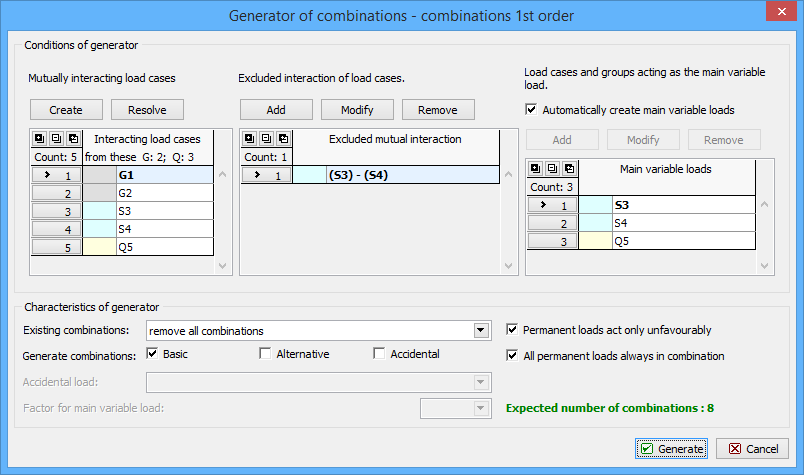Generator of combinations
This window contains parameters of batch input of load combinations. Due to character of the standard EN 1990, large number of load combinations may be created by the generator. As such number may cause slowing down the program work, the expected number of generated combinations is shown in the right bottom corner of the window. User is able to check this number and modify the specified rules to get acceptable number of generated combinations. Upper part of the window contains tools for input of combination rules, bottom part contains generator settings.
Mutually interacting load cases
Selected load cases may be merged together into groups. Load cases in these groups will be in all combinations together. Permanent and variable loads can't be merged into one group. The groups of permanent load cases won't be considered if the setting "All permanent loads in combination" in "Characteristics of generator" is switched on, as any combination will contain all permanent loads. The merged permanent load cases will be considered only for distinguishing the favourable and unfavourable effects of loads (provided that the setting "Permanent loads act only unfavourably" isn't switched on).
Excluded interaction of load cases
The load cases that can't appear together in one combination may be specified in this part. Both load cases and groups of load cases may be excluded here. The rules aren't limited by the type of load cases
Exclusion may be specified using two ways:
Mutual exclusion | - More load cases can be added in such group. Generated combination will contain no more than one load case from this group. This option is suitable e.g. for more variants of snow load applied to the structure.
|
Exclusion by couples | - This option may be used for cases where one load case should be excluded with more different load cases. The load case that should be excluded with others has to be selected in the first column. Arbitrary number of load cases may be selected in the second column. These load cases won't be considered in combinations together with the load case specified in the first column. This option is suitable e.g. for exclusion of construction load and loads applied to the finished structure.
|
Load cases and groups acting as the main variable load
Any variable load case is considered as a main variable load in the default mode. This mode may be switched off with the help of the check box "Automatically create main variable loads". After that, certain load cases may be removed from the list of main variable loads or may be merged together. These merged load cases will be considered as main variable load in one combination.
Characteristics of generator
Keep existing combinations | - The existing combinations will remain in the project and new combinations will be added after closing the window with the help of button "Generate".
|
Remove all combinations | - The existing combinations will be replaced by the new combinations after closing the window with the help of button "Generate".
|
Remove generated combinations | - The existing automatically generated combinations will be replaced by the new generated combinations after closing the window with the help of button "Generate". The existing manually specified combinations will remain in the project.
|
Remove all combinations of the current type | - The existing combinations of the selected type (in part "Generate combinations") will be replaced by the new combinations after closing the window with the help of button "Generate".
|
Remove generated combinations of the current type | - The existing combinations of the selected type (in part "Generate combinations") will be replaced by the new generated combinations after closing the window with the help of button "Generate". The existing manually specified combinations will remain in the project.
|
Generate combinations
These combinations are available for ultimate limit state:
Basic | - The fundamental combination according to the formula (6.10) of EN 1990
|
Alternative | - The combinations according to the formulas (6.10a) and (6.10a) of EN 1990. Two combinations are considered in the analysis for this option. First combination contains reduced permanent load cases, second one contains reduced main variable load.
|
Accidental | - The accidental combination according to the formula (6.11) of EN 1990. The accidental load may be selected for combination type "Accidental". This load case can be selected in the bottom part from the list of entered accidental load cases. Accidental combinations may be entered also without any accidental load case. This option is common for the analysis of fire resistance of the structures. The option "Not specified" in the list of accidental load cases has to be selected in these cases. The combination factor (ψ1 or ψ2) has to be specified for the accidental load
|
Following combinations are available for serviceability limit state:
Characteristic | - The combination according to the formula (6.14) of EN 1990
|
Frequent | - The combination according to the formula (6.15) of EN 1990
|
Quasi-permanent | - The combination according to the formula (6.16) of EN 1990
|
Final deformation | - The combination for the calculation of final deflection for timber structures. These combinations are based on the chapter 2.2.3(5) of EN 1995-1-1. These combinations shows relevant values only for deformations. Internal forces are increased due to creep effect and shouldn't be used for the design.
|
 Generator of combinations
Generator of combinations
 Generator of combinations
Generator of combinations